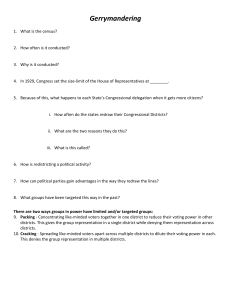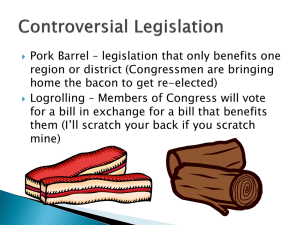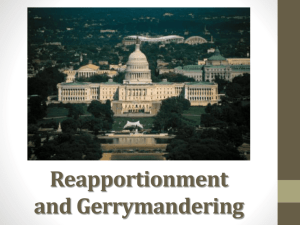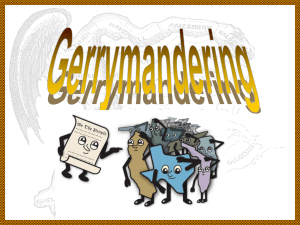Supreme Court of the United States In The
advertisement
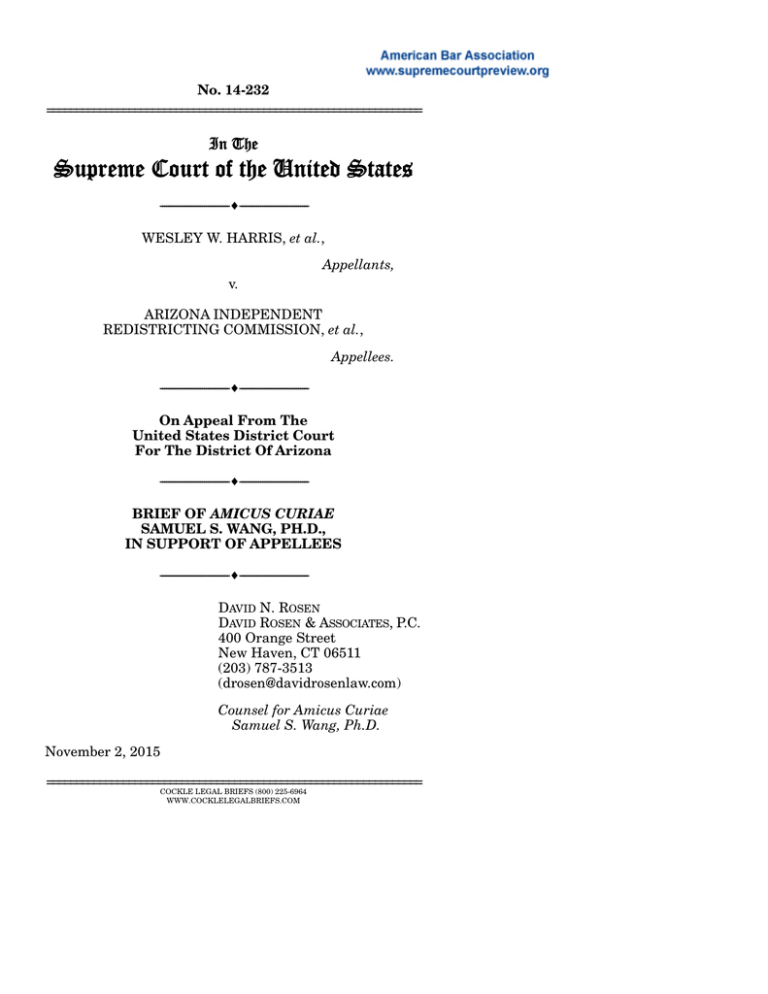
No. 14-232 ================================================================ In The Supreme Court of the United States -----------------------------------------------------------------WESLEY W. HARRIS, et al., Appellants, v. ARIZONA INDEPENDENT REDISTRICTING COMMISSION, et al., Appellees. -----------------------------------------------------------------On Appeal From The United States District Court For The District Of Arizona -----------------------------------------------------------------BRIEF OF AMICUS CURIAE SAMUEL S. WANG, PH.D., IN SUPPORT OF APPELLEES -----------------------------------------------------------------DAVID N. ROSEN DAVID ROSEN & ASSOCIATES, P.C. 400 Orange Street New Haven, CT 06511 (203) 787-3513 (drosen@davidrosenlaw.com) Counsel for Amicus Curiae Samuel S. Wang, Ph.D. November 2, 2015 ================================================================ COCKLE LEGAL BRIEFS (800) 225-6964 WWW.COCKLELEGALBRIEFS.COM i TABLE OF CONTENTS Page TABLE OF AUTHORITIES ................................... ii INTEREST OF AMICUS CURIAE ........................ 1 SUMMARY OF ARGUMENT ................................ 1 ARGUMENT ........................................................... 2 CONCLUSION ....................................................... 8 ii TABLE OF AUTHORITIES Page OTHER AUTHORITIES Andrew Gelman & Gary King, A Unified Method of Evaluating Electoral Systems and Redistricting Plans, 38 AMERICAN JOURNAL OF POLITICAL SCIENCE 514 (1994) .............................................5 Arizona’s Secretary of State, State of Arizona Official Canvass, General Election (2014), available at http://apps.azsos.gov/election/2014/ General/Canvass2014GE.pdf ...................................3 Karl Pearson, Contributions to the Mathematical Theory of Evolution, II: Skew Variation in Homogeneous Material, TRANSACTIONS OF THE ROYAL PHILOSOPHICAL SOCIETY, SERIES A, 186, 343 (1895) ..................................................................7 Pennsylvania’s 2012 Congressional elections, Statistics of the Presidential and Congressional Election of November 6, 2012, Clerk of the U.S. House of Representatives, http:// history.house.gov/Institution/Election-Statistics/ Election-Statistics/ ....................................................7 Samuel S.-H. Wang, A Three-Prong Standard for Practical Evaluation of Partisan Gerrymandering, SOCIAL SCIENCE RESEARCH NETWORK (2015), http://papers.ssrn.com/sol3/papers. cfm?abstract_id=2671607 .....................................7, 8 G. Udny Yule & Maurice G. Kendall, An Introduction to the Theory of Statistics (3d ed. 1950) ..........................................................................7 1 INTEREST OF AMICUS CURIAE1 Amicus Samuel S. Wang, Ph.D., operates the Princeton Election Consortium blog, which since 2004 has been devoted to statistical analysis of election processes and predictions (see http://election.princeton. edu/). He is Professor of Neuroscience and Faculty Associate of the Program in Law and Public Affairs, both at Princeton University. Amicus submits this brief as an individual; institutional affiliation is noted for informational purposes only and does not indicate endorsement by his institutional employer of positions advocated herein. ------------------------------------------------------------------ SUMMARY OF ARGUMENT This brief proposes that gerrymandering claims like the one in this case should be analyzed by looking at the statewide effect of a redistricting plan, and it offers a method for doing so that is simple, elegant, and well-suited to the task. The method is to compare each party’s vote in the median district with each party’s average (mean) vote across all districts. A large spread between these two percentages shows that one party’s voters have been packed into some 1 No counsel for a party authored this brief in whole or in part. No person other than amicus curiae or his counsel made a monetary contribution intended to fund the preparation or submission of this brief. The parties have consented to the filing of this brief. 2 districts, signaling a gerrymandered advantage for the other party. In this case there is no such spread, and in fact Republicans, who are claimed to have been victimized by gerrymandering, are shown to be the modest beneficiaries of the redistricting plan. ------------------------------------------------------------------ ARGUMENT Appellants in this action contend that the Arizona Independent Redistricting Commission (“Commission”) created a slate of districts with unequal population for the express purpose of implementing a partisan gerrymander. The only empirical evidence appellants cite to this Court of any discernible partisan effect of the Commission’s map is that in the 2012 election, “legislators elected from districts identified by the Commission as minority ability-to-elect districts were all Democrats” (Appellants’ Br. at 17) (citing Harris, J.S. App. 37a-38a), and that “the 2014 election [also] demonstrated the commission’s desired effect, with Democrats winning twenty-nine out of thirty senate and house seats in the ten ability-toelect districts.” But it is well known that minority voters in the ability-to-elect districts – Latinos and Native Americans – overwhelmingly support Democrats, so this argument is circular. Of course Democratic-leaning districts systematically elect Democrats, just as the Republican-leaning voters in fourteen districts elected Republicans in all 42 out of 42 Senate and House 3 races in 2014.2 The argument misses the distinction between single-district and statewide gerrymandering. A single-district gerrymander eliminates competition in only one race, while statewide gerrymandering consists of a pattern of many single-district gerrymanders that combine to distort the overall outcome. Appropriately testing the empirical proposition that a statewide map systematically disadvantaged Republicans therefore requires a method that adequately takes into account all districts. This brief suggests an approach to determining whether districting has led to a systematic partisan gerrymander. The statewide gerrymanderer’s objective is to pack an opposing party’s votes into a small number of districts so that the opposing party will win big where it wins even as it wins few districts. Such districting can be expected to result in a specific kind of asymmetry in the distribution of party vote shares across districts: the targeted party will win less than its statewide average vote share in a relatively large fraction of districts, while winning greater than its statewide average vote share in a relatively small fraction of districts. Equivalently, the gerrymandering party will lose big in a small number of districts while winning by closer margins in more districts. 2 Those victories occurred in Districts 1, 5, 6, 12, 13, 14, 15, 16, 17, 20, 21, 22, 23, and 25. Arizona’s Secretary of State, State of Arizona Official Canvass, General Election (2014), available at http://apps.azsos.gov/election/2014/General/Canvass2014GE.pdf. 4 Such systematic rigging of districts will generally show up in election results via differences in a party’s average district vote share on the one hand, and the median vote share it receives on the other. By packing opposing voters into a small number of districts, the gerrymandering party holds down the targeted party’s vote shares in many districts, which depresses the targeted party’s median vote share, even while its average (mean) vote share is unchanged. For these reasons, there is evidence of a systematic gerrymander when a party’s median vote share is substantially below its average vote share across districts. In 2014, the Democratic two-party share of the total Senate vote in all 30 Arizona districts was, in terms of percentages and sorted in ascending order:3 0.0, 0.0, 0.0, 0.0, 0.0, 29.5, 30.5, 34.1, 34.8, 35.7, 36.8, 37.5, 39.8, 39.9, 41.0, 44.7, 46.3, 50.7, 52.3, 53.8, 55.0, 58.0, 60.3, 62.3, 66.1, 74.3, 100.0, 100.0, 100.0, 100.0. Races won by Republicans are indicated in italics and the two middle values are underlined. The median percentage is the midpoint of these two middle values, and is equal to 42.8%. The average of the listed Democratic vote share is 46.1%, yielding an average/median difference of 3.3%. Because the median Democratic vote share is less than the average, 3 The two-party values here are calculated from the final voter canvass. Unopposed races are indicated by 0.0 or 100.0. Id. 5 the districting map operated in a direction that gives a slight advantage to Republicans – the opposite of appellants’ contention. Accordingly, the 2014 Senate results indicate that there is no gerrymandering favoring Democrats. In Arizona’s House races, each legislative district has two members. Using the vote share of the Democratic party’s top finisher in each district as the basis for calculating the district’s vote share, the Democratic two-party share of the total vote in all 30 4 districts was: 0.0, 0.0, 25.3, 30.5, 32.2, 32.3, 34.1, 34.7, 35.3, 39.4, 39.7, 39.9, 42.7, 43.3, 43.6, 45.5, 46.1, 48.1, 50.4, 51.9, 52.2, 52.5, 54.9, 55.0, 57.8, 59.5, 62.3, 75.9, 100.0, 100.0 where the races are listed in the same way as the Senate races. In this case the Democratic median was 44.5%, and the Democratic average vote share was 46.2%. The difference is a gap of 1.7% – again in a direction that favors Republicans.5 4 The two-party values here are calculated from the final voter canvass. Id. 5 The question arises of how to treat uncontested races, since the preferences of voters in those districts might differ if the boundaries were drawn differently. Dropping the uncontested races from the calculation, the average-median difference still favors Republicans, by 4.1% for Senate races and by 1.0% in House races. For other approaches to accounting for uncontested races, see Andrew Gelman & Gary King, A Unified Method of (Continued on following page) 6 Thus for both Senate and House seats, the 2014 Arizona state election results indicate that any partisanship effects of the redistricting process actually benefitted Republicans rather than Democrats (though any such benefits were not statistically significant). For purposes of the present case, then, this Court should be skeptical of appellants’ assertion that the Commission attempted to systematically disfavor Republican voters: If the Commission was trying to do that, the actual election results indicate that it did a poor job. The difference between the average and the median does sometimes indicate that there has been systematic gerrymandering. Take the example of Pennsylvania’s 2012 Congressional elections. The Democratic candidate’s share of the total two-party vote in all 18 districts was, in terms of percentages and sorted in ascending order: 34.4, 36.0, 37.1, 38.3, 40.3, 40.6, 41.5, 42.9, 43.2, 43.4, 45.2, 45.2, 48.3, 60.3, 69.1, 76.9, 84.9, 90.6. The median percentage is the midpoint of the two middle values – 43.3%. By comparison, the average Democratic vote share is 51.0%. The difference of 7.7% pointed in a direction favoring Republicans, who controlled the post-2010 redistricting. Statistical significance testing, which may be based on statistical Evaluating Electoral Systems and Redistricting Plans, 38 AMERICAN JOURNAL OF POLITICAL SCIENCE 514, 550 (1994). 7 properties of the difference between the average and the median,6 reveals that such a difference would arise by chance less than 1% of the time.7 Thus the difference of 7.7% between the average and the median vote share means that Pennsylvania’s post-2010 Census map might be viewed as systematically un8 derrepresenting Democratic voters. The essential point is that deviation from neutrality in districting may be assessed mathematically. The average-median difference test is a straightforward measure of that deviation. It is also true, however, that there exist other measures that will, appropriately, yield closely similar results. For example, one measure compares the difference between the share of Democratic votes in the districts that Democrats win, and the share of Republican votes in the districts they win. As with the average-median difference, this 6 Karl Pearson, Contributions to the Mathematical Theory of Evolution, II: Skew Variation in Homogeneous Material, TRANSACTIONS OF THE ROYAL PHILOSOPHICAL SOCIETY, SERIES A, 186, 343 (1895); G. Udny Yule & Maurice G. Kendall, An Introduction to the Theory of Statistics 162-3 (3d ed. 1950). 7 Samuel S.-H. Wang, A Three-Prong Standard for Practical Evaluation of Partisan Gerrymandering, SOCIAL SCIENCE RESEARCH NETWORK 1, 43 (2015), http://papers.ssrn.com/sol3/papers. cfm?abstract_id=2671607. 8 There were roughly 5.56 million votes cast in Pennsylvania’s 2012 Congressional elections, Statistics of the Presidential and Congressional Election of November 6, 2012, Clerk of the U.S. House of Representatives, http://history.house.gov/Institution/ Election-Statistics/Election-Statistics/; 7.7% of this figure is 428,000 votes. 8 test works because in a partisan gerrymander, the targeted party wins lopsided victories in a small number of districts, while the gerrymandering party’s wins are engineered to be relatively narrow. In Arizona’s Senate races in 2014, the average winning Republican vote share was 73%, while the average winning Democratic vote share was 72%. This difference – one percentage point – is not statistically significant.9 In House races, Republicans won with an average of 66% in those districts they won, while Democrats won with 64% in those districts they won (again, the difference was not statistically significant). Like the difference between the average and the median, this second measure also shows that if the Commission was trying to engineer a map that systematically disfavored Arizona Republicans, it did a poor job. ------------------------------------------------------------------ CONCLUSION In sum, because the results of Arizona’s elections are inconsistent with the existence of an effective anti-Republican partisan gerrymander, this Court should reject appellants’ argument insofar as it relies 9 See Wang, note 7, supra, for details on the computation of statistical significance. 9 on any such intention by the Commission to disadvantage Republicans. Respectfully submitted, DAVID N. ROSEN DAVID ROSEN & ASSOCIATES, P.C. 400 Orange Street New Haven, CT 06511 (203) 787-3513 (drosen@davidrosenlaw.com) Counsel for Amicus Curiae Samuel S. Wang, Ph.D. November 2, 2015





